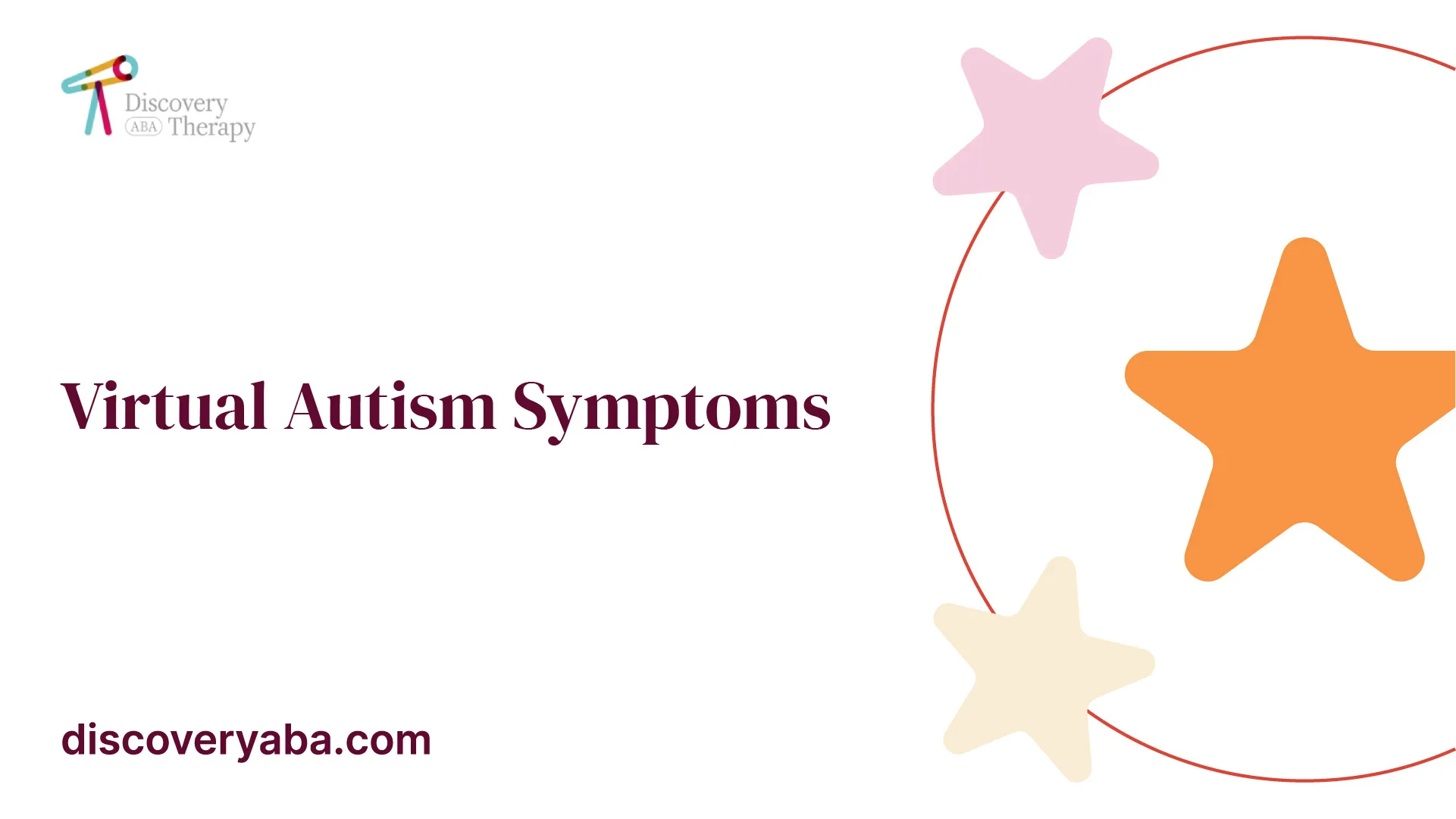Virtual Autism Symptoms
Unlock the symptoms and insights of virtual autism in the digital world. Discover how excessive screen time impacts communication and behavior.

Understanding Virtual Autism
In the digital age, the concept of virtual autism has emerged to describe a set of symptoms that arise due to excessive screen exposure during a crucial developmental period. Although not an officially recognized medical diagnosis, virtual autism refers to the effects of prolonged screen time on young children, resulting in autism spectrum disorder (ASD)-like symptoms such as communication problems and behavior oddities [1].
Definition and Context
Virtual autism occurs when young children, typically below the age of two, are excessively exposed to screens, including phones, tablets, televisions, computers, and laptops. Prolonged screen time during this critical developmental phase can disrupt the natural processes of social interaction, language development, and cognitive abilities in young children. Increased screen time has been associated with negative health outcomes, including decreased cognitive ability, impaired language development, mood issues, and autistic-like behaviors such as hyperactivity, short attention span, and irritability.
It is essential to understand that virtual autism is not an official diagnosis recognized by medical professionals. Instead, it is a term used to describe the specific set of symptoms that manifest as a result of excessive screen exposure during a critical period of development. The impact of excessive screen time on young children's development is an area of ongoing research and discussion among experts in the field.

Impact of Excessive Screen Time
Excessive screen time during early childhood can have a profound impact on behavioral and developmental milestones. Children who are exposed to more than three hours of screen time per day may experience language delays, shorter attention spans, and increased hyperactivity. The immersive and stimulating nature of screens can potentially hinder the development of essential skills, such as social interaction, language acquisition, and emotional regulation.
The COVID-19 pandemic has further highlighted the reliance on screens for educational and recreational activities, leading to an increase in screen time for many children. It is important for parents and caregivers to be mindful of the potential negative consequences of excessive screen exposure and take steps to promote a healthy balance between screen time and other developmentally beneficial activities.
Understanding virtual autism and its impact on young children is crucial for parents, educators, and healthcare professionals. By recognizing the potential risks associated with excessive screen time, proactive measures can be taken to mitigate these effects and support healthy development in children.
Symptoms of Virtual Autism
Virtual autism, which is not an officially recognized medical diagnosis but rather a term used to describe a specific set of symptoms that arise due to excessive screen exposure during a crucial developmental period, can manifest in various ways. These symptoms often resemble those of autism spectrum disorder (ASD) and may include communication challenges and behavior patterns.
Communication Challenges
Children affected by virtual autism may experience difficulties in communication. These challenges can range from delayed language development to limited vocabulary and impaired social interactions. Some common communication-related symptoms include:
- Delayed language milestones: Children may exhibit delays in reaching language development milestones, such as babbling, speaking their first words, or forming sentences.
- Limited vocabulary: The child's vocabulary may be restricted, with a reduced range of words and difficulty expressing themselves verbally.
- Poor eye contact: Children may exhibit reduced eye contact during interactions, making it challenging to engage in conversations or establish connections with others [3].
- Difficulty understanding social cues: Understanding non-verbal cues, such as facial expressions and body language, can be challenging for children with virtual autism, impacting their ability to interpret social situations effectively.
Behavior Patterns
Children with virtual autism may display behavior patterns that resemble those seen in individuals with autism spectrum disorder. These behavior patterns can vary in severity and may include:
- Hyperactivity: Restlessness and excessive physical movement, such as fidgeting, running around, or constantly shifting positions.
- Short attention span: Difficulty focusing on tasks or activities for an extended period, often leading to frequent distractions and an inability to sustain attention.
- Irritability: Increased sensitivity to stimuli and a tendency to become easily frustrated or agitated in response to minor triggers.
- Repetitive behaviors: Engaging in repetitive actions or movements, such as hand-flapping, rocking back and forth, or repeating certain phrases or words.
It's important to note that the symptoms of virtual autism can be reversible once screen time is reduced or eliminated, and real-life interactions are prioritized. By addressing the excessive screen exposure, children may experience significant improvements in their behavior and overall development.
Factors Contributing to Virtual Autism
Virtual autism is primarily caused by prolonged screen exposure, particularly in young children. The excessive screen time, including phones, tablets, television, computers, and laptops, can disrupt the natural developmental processes of young children, affecting their social interactions, language development, and cognitive abilities.
Prolonged Screen Exposure
Excessive screen time in young children has been associated with negative health outcomes, including decreased cognitive ability, impaired language development, mood issues, and autistic-like behavior such as hyperactivity, short attention span, and irritability. Children exposed to more than 3 hours of screen time per day exhibited language delays, short attention spans, and hyperactivity.
It is important to note that the accessibility and immersive nature of digital platforms such as video games and social media have contributed to the increased prevalence of virtual autism. These platforms have become increasingly popular among children, leading to a rise in screen time and potential impact on social and communication skills.
Effects on Development
Prolonged screen exposure during early childhood poses challenges to behavioral and developmental milestones. Children exposed to excessive screen time may experience language delays, reduced attention spans, and increased hyperactivity. The disruption of natural developmental processes can have long-term consequences on a child's social interactions, language development, and cognitive abilities.
To mitigate the potential effects of prolonged screen exposure, it is essential to establish healthy screen time limits for young children. Encouraging alternative activities such as outdoor play, reading, and engaging in creative pursuits can help promote a balanced and well-rounded development.
By understanding the factors contributing to virtual autism, such as prolonged screen exposure and its effects on development, parents and caregivers can take proactive steps to manage and reduce screen time for young children. Prioritizing healthy alternatives and promoting a balanced lifestyle can significantly contribute to a child's overall well-being and development.
Recognizing Virtual Autism
Recognizing the signs and indicators of virtual autism is essential for early identification and intervention. Although virtual autism is not an officially recognized medical diagnosis, it is a term used to describe a specific set of symptoms that arise due to excessive screen exposure during a crucial developmental period. Children with virtual autism may exhibit communication difficulties, behavioral oddities, and deficits in social interactions. It's important to note that these symptoms can often disappear or significantly improve when screen exposure is reduced or eliminated.
Signs and Indicators
When it comes to identifying virtual autism, there are several signs and indicators to look out for. These may include:
- Difficulties in Social Interactions: Children with virtual autism may struggle with social interactions, such as maintaining eye contact, understanding non-verbal cues, and engaging in reciprocal conversations. They may find it challenging to establish and maintain relationships with peers and adults [1].
- Delayed Language Development: Language delays are often observed in children with virtual autism. They may have difficulty expressing themselves verbally, understanding instructions, or using appropriate language for their age. Limited vocabulary and grammar skills can be evident.
- Reduced Eye Contact: Children with virtual autism may exhibit limited or decreased eye contact. They may struggle to establish visual connections with others, which can impact their social interactions and ability to engage with others.
- Limited Emotional Expression: Emotional expression can be restricted in children with virtual autism. They may have difficulty expressing a wide range of emotions appropriately, leading to challenges in understanding and responding to emotional cues from others.
Behavioral Oddities
Behavioral oddities are another key aspect of virtual autism. Children with virtual autism may display various behavioral patterns, including:
- Aggression and Irritability: Excessive screen time can contribute to behavioral issues such as aggression, irritability, and impulsivity. Children may demonstrate increased tantrums, frustration, and difficulty managing their emotions.
- Hyperactivity and Short Attention Span: Children with virtual autism may exhibit hyperactive behavior and have a shorter attention span. They may struggle to focus on tasks or engage in sustained activities for an appropriate duration.
- Sleep Disturbances: Prolonged screen exposure can disrupt sleep patterns in children, leading to difficulties falling asleep, staying asleep, or experiencing restful sleep. Sleep disturbances can further impact their behavior and overall well-being.
It's important to note that the symptoms of virtual autism are reversible once screen time is reduced and real-life interactions are prioritized. By recognizing the signs and behavioral oddities associated with virtual autism, parents, caregivers, and educators can take appropriate steps to address and manage the condition effectively [1].
Assessing Virtual Autism
When it comes to assessing virtual autism, there are specific evaluation methods that professionals utilize to identify and diagnose this condition. However, there are also challenges that arise when diagnosing virtual autism due to the unique nature of the digital world and remote assessments.
Evaluation Methods
Virtual autism assessments typically involve a comprehensive evaluation process that includes various methods to gather information and make an accurate diagnosis. These evaluation methods may include:
- Parental Interviews: Clinicians conduct interviews with parents or caregivers to gather information about the child's behavior, communication patterns, and any concerns they may have noticed regarding their child's interaction with digital devices.
- Behavioral Observation: Professionals observe the child's behavior during virtual interactions, paying attention to their engagement, attention span, and social interactions in the digital environment.
- Questionnaires and Rating Scales: Standardized questionnaires and rating scales may be utilized to assess specific behaviors and symptoms associated with virtual autism. These tools help provide a quantitative measure of the child's behavior and aid in the diagnostic process.
- Video Analysis: Video recordings of the child's interactions with digital devices can provide valuable insights for professionals to analyze their behavior, communication, and social interactions in the virtual environment.
It's important to note that the evaluation methods used for virtual autism assessments have evolved due to the shift towards remote evaluations during the COVID-19 pandemic. Clinicians and researchers have adapted to this shift by exploring new ways to conduct assessments remotely, allowing for increased accessibility and convenience. Virtual assessments have presented both challenges and opportunities, enabling professionals to gain insights into the lives and behaviors of individuals with autism within their home environment, offering a more holistic understanding of their condition.
Challenges in Diagnosis
Diagnosing virtual autism comes with its own set of challenges. Some of the difficulties encountered in the diagnosis process include:
- Capturing Behaviors: Virtual assessments may not fully capture certain behaviors and interactions that are better observed in person. Some behaviors may be missed or difficult to interpret solely through digital interactions.
- Limited Environment: Virtual assessments primarily focus on the child's behavior and interactions within the digital environment. This limited scope may not provide a comprehensive understanding of the child's behavior in other settings, such as school or social situations.
- Lack of Physical Presence: Professionals conducting virtual assessments may not have the opportunity to directly interact and engage with the child, which can limit their ability to accurately assess certain aspects of their behavior and social communication skills.
Despite these challenges, virtual assessments for autism have also brought about benefits such as increased accessibility, reduced waitlists, and improved diversity and inclusion efforts. The ability to conduct assessments remotely has eliminated the need for travel and reduced logistical challenges, making diagnostic tools and resources more accessible to individuals and families, particularly those in remote areas or with limited access to specialized healthcare services [5].
As professionals continue to navigate the world of virtual autism assessments, they are adapting their approaches to address these challenges and ensure accurate diagnoses. The rise of virtual assessments has not only transformed the diagnostic process but has also brought about positive changes in terms of accessibility and inclusivity [5].
Managing Virtual Autism
When it comes to managing virtual autism, it is crucial to implement prevention strategies and provide the necessary support and intervention for affected individuals.
Prevention Strategies
Prevention is key when it comes to virtual autism. It is important to limit screen time for young children, especially those below the age of two, as excessive screen exposure during this critical developmental period has been associated with the emergence of autism-like symptoms. Here are some prevention strategies to consider:
- Establish screen time limits: Set clear boundaries and limits on the amount of time young children spend in front of screens. The American Academy of Pediatrics recommends no screen time for children under the age of 18 months, except for video chatting with family [1].
- Encourage alternative activities: Encourage children to engage in other activities that promote healthy development, such as outdoor play, social interactions, imaginative play, and reading. Provide a variety of stimulating and age-appropriate toys and activities to keep children engaged.
- Model healthy screen use: Be a positive role model by demonstrating healthy screen use habits yourself. Limit your own screen time and prioritize face-to-face interactions with your child.
- Create screen-free zones: Designate certain areas in your home, such as bedrooms or mealtime areas, as screen-free zones. This helps to promote family interactions and reduces the temptation for excessive screen use.
Support and Intervention
For children already exhibiting symptoms of virtual autism, providing appropriate support and intervention is crucial for their development and well-being. Here are some strategies to consider:
- Reduce screen exposure: The first step in managing virtual autism is to reduce or eliminate screen exposure. Studies have shown that when screen time is reduced or eliminated, the symptoms of virtual autism often improve significantly. Encourage alternative activities that promote social interaction, communication, and cognitive development.
- Seek professional guidance: Consult with healthcare professionals, such as pediatricians, psychologists, or developmental specialists who have experience working with children with autism or similar developmental challenges. They can provide guidance and tailored intervention strategies based on the child's specific needs.
- Early intervention services: Early intervention services, such as speech therapy, occupational therapy, and behavioral therapy, can play a crucial role in supporting the development of children with virtual autism. These services are designed to address specific areas of need and help children improve their communication skills, behavior, and social interactions.
- Parent education and support: Parents and caregivers play a vital role in supporting children with virtual autism. It is important to educate yourself about the condition, seek support from relevant support groups or organizations, and collaborate with professionals to implement effective strategies at home.
Managing virtual autism requires a multidimensional approach that involves prevention, reducing screen exposure, and providing appropriate support and intervention. By implementing these strategies, parents and caregivers can help promote healthy development and well-being for children affected by virtual autism.
References
- [1]: https://www.abtaba.com/blog/virtual-autism-symptoms
- [2]: https://www.abtaba.com/blog/virtual-autism-and-how-is-it-assessed
- [3]: https://www.sunshinepreschools.com/blog/virtual-autism-concern-for-toddlers-in-digital-age
- [4]: https://www.autismparentingmagazine.com/children-virtual-autism/
- [5]: https://www.abtaba.com/blog/virtual-autism-evaluation
Does Your Child Have An Autism Diagnosis?
Learn More About How ABA Therapy Can Help
Find More Articles
Contact us
North Carolina, Nevada, Utah, Virginia
New Hampshire, Maine
Arizona, Colorado, Georgia, New Mexico, Oklahoma, Texas
.avif)




































































































